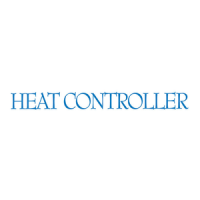
Do you have a question about the Heat Controller GLUA75-E3C and is the answer not in the manual?
| Weight | 120 lbs |
|---|---|
| BTU | 75, 000 BTU |
| Efficiency | 80% |
| Fuel Type | Natural Gas |
| Vent Diameter | 4 inch |
Crucial safety warnings regarding furnace operation, installation, and potential hazards.
Specific warning against installing the furnace in mobile homes due to safety risks.
Safety guidelines for installing the furnace in a residential garage, focusing on ignition sources.
Guidelines for keeping areas around the furnace clear of flammable materials.
Preventing combustion products from entering return air and living spaces.
Critical warnings related to furnace venting to prevent CO poisoning, explosion, or fire.
Warnings about providing adequate combustion air to prevent CO poisoning or explosion.
Warnings about power disconnection, proper grounding, and blower door switch safety.
Specific requirements for side wall horizontal venting in MA, including CO detectors and signage.
Explains how duct leaks affect efficiency, air quality, and safety, requiring sealing.
Warnings about combustible floors, lifting by heat exchanger, and combustible material proximity.
Warning against allowing combustion gases into return air, stressing duct sealing.
Critical warning about improper venting causing CO poisoning, explosion, or fire.
Crucial warning against bypassing safety switches, emphasizing professional diagnosis.
Critical warnings and requirements for providing adequate combustion and ventilation air.
Instructions and warnings for installing non-direct vent systems, including pipe slope and support.
Detailed requirements for locating vent terminals to avoid hazards and nuisance from condensate.
Information on dedicated combustion air and venting systems for direct vent furnaces.
Specifies the required combustion air system for direct vent furnaces.
Minimum clearances and guidelines for horizontal direct vent termination locations.
Steps for converting the unit's condensate drain for horizontal installation.
Information on natural gas only, LP conversion kits, and recommended detectors.
Guidelines for installing gas piping according to codes and utility company requirements.
How to measure and adjust supply gas pressure to the furnace, including altitude considerations.
How to measure and adjust manifold gas pressure for proper furnace input.
Warnings about power disconnection, proper grounding, and blower door switch safety.
Details on specific kits for converting furnaces for high altitude operation.
Cautions and requirements for installing furnaces at altitudes above 2000 ft, including derating.
Guidance on installing LP gas orifices, noting differences from NFGC for Rheem products.
Step-by-step guide for starting the furnace and verifying operation.
Importance of checking furnace input to prevent over-firing and ensuring correct operation.
Instructions for setting the furnace input rate based on gas heating value and orifice size.
Explains the critical role of air flow for heat exchanger efficiency and preventing damage.
Steps for measuring and checking the temperature rise to ensure correct air flow.
Warning to set temperature rise close to the middle of the range to avoid damage and voiding warranty.
Warnings and instructions for changing blower speeds, emphasizing safety and checking temperature rise.
Warnings for service personnel regarding installation, adjustment, and operation safety.
